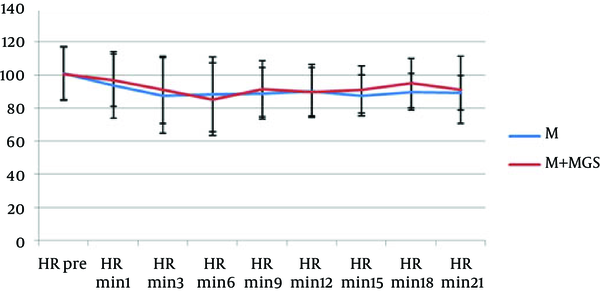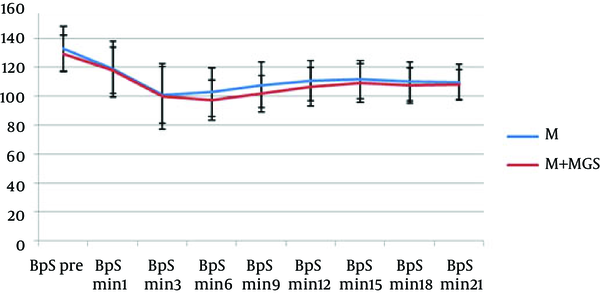Abstract
Background:
Spinal anesthesia is widely used for caesarean section. Addition of intrathecal magnesium sulfate to local anesthetics seems to improve the quality of block and prolong the duration of analgesia.Objectives:
The present study was designed to examine whether addition of intrathecal magnesium sulfate enhances the analgesic efficacy of intrathecal bupivacaine in patients undergoing cesarean section.Patients and Methods:
We conducted a randomized, prospective, double-blind, case-control, clinical trial. Eighty patients were scheduled for cesarean section under spinal anesthesia. The patients were randomly allocated to receive either 10 mg of hyperbaric bupivacaine 0.5% (control group) or 10 mg of hyperbaric bupivacaine 0.5% plus 50 mg magnesium sulfate (case group) intrathecally. Hemodynamic variability, onset and duration of block and duration of analgesia were evaluated.Results:
The onset of sensory blockade was delayed in case group compared with control group, and this was statistically significant. The onset of motor blockade had no difference in both groups. The duration of motor blockade was similar. Post-operative analgesia was longer in magnesium sulfate group but the difference was not meaningful. The intraoperative hemodynamic variability showed no significant differences between groups.Conclusions:
This study showed that the addition of intrathecal magnesium sulfate to bupivacaine is not desirable in patients undergoing cesarean section due to the delay in the onset of sensory blockade and the lack of significant effects of magnesium on post-operative pain.Keywords
Spinal Anesthesia Bupivacaine Magnesium Sulfate Cesarean Section
1. Background
Regional anesthesia is a safe and inexpensive technique which is widely used in cesarean section. It reduces the risk of airway complications and avoids hemodynamic changes associated with laryngoscopy and intubation (1, 2). Recently, application of intrathecal adjuvants has gained popularity with the aim of prolonging the duration of block, better success rate and patient satisfaction (1-4). Opioids such as sufentanil are commonly used as additives to local anesthetics to prolong the duration and intensify the effects of subarachnoid block (2). However significant side effects of opioids such as pruritus, urinary retention, respiratory depression, hemodynamic instability, occasionally severe nausea and vomiting may limit their use (1-3).
It has been shown that the duration of postoperative analgesia was prolonged when magnesium is given as an adjunct for peripheral nerve blocks (5). A few clinical trials have examined the effect of adding intrathecal MgSO4 to anesthetic agents such as bupivacaine (6-8), yet the mechanisms of action are not clear. Anti-nociceptive effects of Mg are probably due to regulation of calcium influx into the cell and antagonisation of N-methyl D-aspartate (NMDA) receptors. In the human body, calcium channel blockers can increase the analgesic effects of opioids. The analgesic effect of magnesium is due to its effect on NMDA receptors. N-methyl D-aspartate receptor has negative modulatory sites for agents such as magnesium. Furthermore, it is coupled with ion channels such as K+ and Ca2+. Magnesium causes a voltage-dependent block on NMDA receptors (6-10).
2. Objectives
The present study was designed to examine whether addition of intrathecal magnesium sulfate would enhance the analgesic efficacy of intrathecal bupivacaine in patients undergoing cesarean section.
4. Results
All patients completed the study, with 40 patients in the magnesium sulfate group (case group) and 40 in the control group. The patients’ characteristics including age and weight were similar between the two groups (Table 1). The onset of sensory blockade in the bupivacaine group was more rapid than the magnesium sulfate group (P = 0.01), yet the onset of motor blockade was not different in both groups (P = 0.56) (Table 2). The duration of motor blockade was not significantly different between the two groups. Time for regression of four sensory blocks was similar (P = 0.19). Duration of analgesia was longer in the magnesium sulfate group yet this difference was not significant (P = 0.07) (Table 2).
Hemodynamic parameters such as heart rate and systolic blood pressure were similar in both groups (Figures 1 and 2). Three patients in the magnesium sulfate group and one patient in the control group experienced nausea and vomiting. Postoperative follow-up revealed uneventful recovery in all patients. No neurologic deficit was observed in any of the patients. Apgar score of babies (at one, five and ten minutes) was similar in both groups.
| Variable | Control Group | MgSo4 Group | P Value |
|---|---|---|---|
| Age, y | 27.48 ± 4.49 | 26.88 ± 4.44 | 0.56 |
| Weight, kg | 78.13 ± 10.89 | 83.10 ± 11.91 | 0.08 |
| Variable | Control Group | MgSo4 Group | P Value |
|---|---|---|---|
| Onset time of sensory block, min | 5.65 ± 0.92 | 6.60 ± 1.12 | 0.01 |
| Onset time of motor block, min | 8.57 ± 5.83 | 7.83 ± 5.67 | 0.56 |
| Duration of 4 dermatome block regressions, min | 61.33 ± 10.16 | 64.28 ± 10.07 | 0.19 |
| Duration of motor block, min | 56.75 ± 32.35 | 61.68 ± 39.37 | 0.54 |
| Duration of analgesia, min | 137.12 ± 9.95 | 160.87 ± 8.37 | 0.07 |
Heart Rate Changes During the Operation (P > 0.05)

Blood Pressure Changes During the Operation (P > 0.05)

5. Discussion
The main finding of this study was that in patients undergoing caesarean section under hyperbaric bupivacaine spinal anesthesia, the addition of 50 mg magnesium sulfate led to a significant delay in the onset of sensory blockade. Indeed, there was no significant difference in the duration of post-operative analgesia and characteristics of motor blockade in the two groups. The study showed that systemic administration of magnesium is associated with less analgesic requirement and less discomfort during the postoperative period (9, 13). Several experiments demonstrated analgesic effects of magnesium sulfate in neuraxial and peripheral block (5-7). It was observed that addition of magnesium sulfate to bupivacaine and fentanyl prolonged the period of anesthesia without additional side-effects (11). In some studies, it was observed that the visual analog scores, first analgesic requirement and total morphine requirement were significantly lower after intrathecal injection of magnesium sulfate (12, 14). In patients undergoing caesarean section under spinal anesthesia, the addition of intrathecal magnesium sulfate (100 mg) to morphine improved the quality and the duration of postoperative analgesia without increasing the incidence of adverse effects (15). Intrathecal magnesium was used for labor analgesia at the dose of 50 mg in addition to fentanyl; a significant prolongation in the duration of analgesia in the magnesium-fentanyl group compared with the fentanyl group was observed (16). Jabalameli and colleagues found that the duration of sensory and motor blockade was significantly prolonged by 75 mg or 100 mg magnesium sulfate compared with 50 mg magnesium sulfate (17). Unlugenc et al. showed that the addition of magnesium sulfate to bupivacaine did not shorten the onset time of sensory blockade or prolong the duration of spinal anesthesia (18). These differences may be due to the dose of intrathecal bupivacaine and magnesium or different surgical procedures.
In our study, we found that the onset of sensory blockade was delayed with the addition of intrathecal magnesium. This finding is similar to a previous study in which it was shown that the addition of intrathecal magnesium sulfate to bupivacaine and fentanyl anesthesia delayed the onset of the sensory and motor blockade (16). Ozalevli et al. observed a similar delay in onset of spinal anesthesia when adding intrathecal magnesium sulfate to fentanyl and isobaric bupivacaine (11). They suggested that the differences in pH and baricity of the solution containing magnesium sulfate contributed to the delayed onset (12, 16).
The optimal dose of intrathecal magnesium has not been reported previously. The dose of magnesium used in this study was based on data from the study of Buvanendran et al. where 50 mg of spinal magnesium sulfate potentiated fentanyl antinociception (16). We suggest further researches in the future, with different magnesium dosages and more patients, to determine the safest route and dosage. This study shows that the addition of intrathecal magnesium sulfate to bupivacaine is not desirable in patients undergoing cesarean section due to the delay in the onset of sensory blockade and the lack of significant effects of magnesium on post-operative pain.
Acknowledgements
References
-
1.
Roelants F. The use of neuraxial adjuvant drugs (neostigmine, clonidine) in obstetrics. Curr Opin Anaesthesiol. 2006;19(3):233-7. [PubMed ID: 16735803].
-
2.
Rasooli S, Parish M, Mahmoodpoor A, Moslemi F, Sanaie S. Effect of spinal low dose bupivacaine-sufentanyl for cesarean section in preeclamptic parturients on neonatal outcome. Shiraz E Med J. 2009;10(4):201-8.
-
3.
Saxena AK, Arava SK. Current concepts in neuraxial administration of opioids and non-opioids: An overview and future perspectives. Indian J Anaesth. 2004;48(1):13-24.
-
4.
Faiz SH, Rahimzadeh P, Imani F, Bakhtiari A. Intrathecal injection of magnesium sulfate: shivering prevention during cesarean section: a randomized, double-blinded, controlled study. Korean J Anesthesiol. 2013;65(4):293-8. [PubMed ID: 24228140].
-
5.
Lee AR, Yi HW, Chung IS, Ko JS, Ahn HJ, Gwak MS, et al. Magnesium added to bupivacaine prolongs the duration of analgesia after interscalene nerve block. Can J Anaesth. 2012;59(1):21-7. [PubMed ID: 22012543]. https://doi.org/10.1007/s12630-011-9604-5.
-
6.
Pascual-Ramirez J, Gil-Trujillo S, Alcantarilla C. Intrathecal magnesium as analgesic adjuvant for spinal anesthesia: a meta-analysis of randomized trials. Minerva Anestesiol. 2013;79(6):667-78. [PubMed ID: 23722295].
-
7.
Faiz SH, Rahimzadeh P, Sakhaei M, Imani F, Derakhshan P. Anesthetic effects of adding intrathecal neostigmine or magnesium sulphate to bupivacaine in patients under lower extremities surgeries. J Res Med Sci. 2012;17(10):918-22. [PubMed ID: 23825989].
-
8.
Khalili G, Janghorbani M, Sajedi P, Ahmadi G. Effects of adjunct intrathecal magnesium sulfate to bupivacaine for spinal anesthesia: a randomized, double-blind trial in patients undergoing lower extremity surgery. J Anesth. 2011;25(6):892-7. [PubMed ID: 21928127].
-
9.
Koinig H, Wallner T, Marhofer P, Andel H, Horauf K, Mayer N. Magnesium sulfate reduces intra- and postoperative analgesic requirements. Anesth Analg. 1998;87(1):206-10. [PubMed ID: 9661575].
-
10.
Tramer MR, Schneider J, Marti RA, Rifat K. Role of magnesium sulfate in postoperative analgesia. Anesthesiology. 1996;84(2):340-7. [PubMed ID: 8602664].
-
11.
Ozalevli M, Cetin TO, Unlugenc H, Guler T, Isik G. The effect of adding intrathecal magnesium sulphate to bupivacaine-fentanyl spinal anaesthesia. Acta Anaesthesiol Scand. 2005;49(10):1514-9. [PubMed ID: 16223399]. https://doi.org/10.1111/j.1399-6576.2005.00793.x.
-
12.
Shoeibi G, Firozian A, Tabassomi F. The Additional Effect of Magnesium Sulfate to Lidocaine in Spinal Anesthesia for Cesarean Section. Int J Pharmacol. 2007;3(5):425-7. https://doi.org/10.3923/ijp.2007.425.427.
-
13.
Shariat Moharari R, Motalebi M, Najafi A, Zamani MM, Imani F, Etezadi F, et al. Magnesium Can Decrease Postoperative Physiological Ileus and Postoperative Pain in Major non Laparoscopic Gastrointestinal Surgeries: A Randomized Controlled Trial. Anesth Pain Med. 2014;4(1). ee12750. [PubMed ID: 24660146]. https://doi.org/10.5812/aapm.12750.
-
14.
Arcioni R, Palmisani S, Tigano S, Santorsola C, Sauli V, Romano S, et al. Combined intrathecal and epidural magnesium sulfate supplementation of spinal anesthesia to reduce post-operative analgesic requirements: a prospective, randomized, double-blind, controlled trial in patients undergoing major orthopedic surgery. Acta Anaesthesiol Scand. 2007;51(4):482-9. [PubMed ID: 17378788]. https://doi.org/10.1111/j.1399-6576.2007.01263.x.
-
15.
Ghrab BE, Maatoug M, Kallel N, Khemakhem K, Chaari M, Kolsi K, et al. [Does combination of intrathecal magnesium sulfate and morphine improve postcaesarean section analgesia?]. Ann Fr Anesth Reanim. 2009;28(5):454-9. [PubMed ID: 19427159]. https://doi.org/10.1016/j.annfar.2009.03.004.
-
16.
Buvanendran A, McCarthy RJ, Kroin JS, Leong W, Perry P, Tuman KJ. Intrathecal magnesium prolongs fentanyl analgesia: a prospective, randomized, controlled trial. Anesth Analg. 2002;95(3):661-6. [PubMed ID: 12198056].
-
17.
Jabalameli M, Pakzadmoghadam SH. Adding different doses of intrathecal magnesium sulfate for spinal anesthesia in the cesarean section: A prospective double blind randomized trial. Adv Biomed Res. 2012;1:7. [PubMed ID: 23210066]. https://doi.org/10.4103/2277-9175.94430.
-
18.
Unlugenc H, Ozalevli M, Gunduz M, Gunasti S, Urunsak IF, Guler T, et al. Comparison of intrathecal magnesium, fentanyl, or placebo combined with bupivacaine 0.5% for parturients undergoing elective cesarean delivery. Acta Anaesthesiol Scand. 2009;53(3):346-53. [PubMed ID: 19173689].